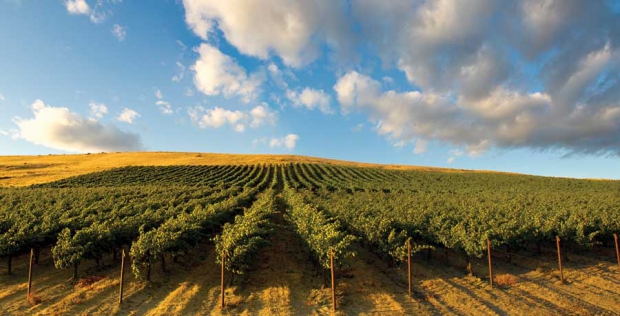
Some of the blocks at Canoe Ridge Estate, first planted in 1991, are scheduled for replanting. As part of the replanting, Ste. Michelle Wine Estates will include a small rootstock trial. (Courtesy Canoe Ridge Estates)
A number of aging wine grape vineyards in Washington State are entering or will soon be in the replanting phase of their lives.

Kevin Corliss
As growers choose new plant material, performance in the vineyard should be the top criterion, says the head of vineyards for Washington’s largest grape grower and wine producer.
“It’s important you make careful, deliberate choices, because the decision will stick with you and impact your profitability for forty-plus years,” said Kevin Corliss, vice president of vineyards at Ste. Michelle Wine Estates.
To ensure good performance in the vineyard, plant material must have superior fruiting capacity and quality traits, such as disease resistance, color, ripening, flavors, and aromas.
Corliss, who has more than 30 years of viticultural experience, recently shared the thought processes that he leads his Ste. Michelle colleagues through when choosing grape plant material for new vineyards or replants.
Start clean
Good vineyard performance starts with certified, clean plants that have been tested for known viruses. “Clean plants are the first thing you should think about when planting a high performance vineyard,” he said. “But you also need to know your vine source—where they come from—because the mother blocks will hold clues to their performance.”
At the very least, he recommends checking with the nursery about what the mother blocks look like, average yields the last ten years, when blocks were last sampled for viruses and which viruses.
Plan A is to use certified vines, but what often happens is Plan B, he said. When certified vines are not available—as many were not in recent years because of rapid expansion of wine grape acreage throughout North America—growers should choose as close to second or next generation as possible and then perform extensive testing to determine the disease status of the block, he recommends.
“We find ourselves in this Plan B situation quite a bit,” he said, adding that they test as many vines as practical, given constraints of time and money. One way to make testing easier is to keep the source block as small as possible. Also, learn as much as you can about the source block and keep detailed records in case you have to use the same source block for several years.
“When it comes to using clean vines, you need to develop a long-term strategic vine-sourcing program,” Corliss said. “You need to know what variety you’ll be planting next and where to source that variety ten years from now. Someone within your organization should be tasked with that.”
Variety, clonal selections
Planting a vineyard for good performance involves matching the variety with the site and style of wine, managing the vineyard properly, and selecting clones that bring complexity to the wine, while improving things like fruiting capacity, resistance to disease, color, or ripening, Corliss said. “Variety always comes first.”
Too many people plant the wrong variety in their site, he said. For example, they want to grow long-season varieties, like Cabernet Sauvignon or Syrah, in cool parts of the state, where the macroclimate conditions just don’t fit the variety.
Another reason he believes varieties have been planted in the wrong location is because Washington is still the “great frontier” of wine grapes, with vineyards planted in areas that were previously sagebrush.
When selecting clones, which are asexually propagated vines and are the exact progeny of their parents, cleanliness is utmost important. “A clean, ho-hum clone is always better than a dirty but ‘hot’ one,” Corliss said.
He believes there is no perfect clone for Washington. Though there is no published research on wine grape clones grown in Washington State, Ste. Michelle has conducted its own clonal research trials since the 1990s and has years of clonal production and wine data.
When selecting a clone, Corliss gives the following advice:
1. Study information from other areas.
2. Cast a wide net in your search. (Sometimes a clone not favored in one region will do well in another. For example, Ste. Michelle has found that a Cabernet Sauvignon clone from Germany, not particularly favored in California, is doing well in Washington.)
3. Draw on the experiences of fellow growers.
4. Expect change through the years in the performance of clones.
5. Continue to evaluate clonal differences.
Ste. Michelle’s clonal trial involves multiple sites throughout the state. Clonal grapes are annually made into wines and the company holds blind tastings several times throughout the year to evaluate wine differences and preferences. Identifying which clone is preferable for wine qualities like flavors and aromas is difficult, he said, because the differences are subtle and often jump around from year to year. Blind tastings are key to shaking out winemaker preferences.
“The best use for clones is to consider them as ‘spices’ that winemakers can use to add diversity and complexity to wine,” he said. “An incorrect choice on the clone side is a learning experience; an incorrect choice with vine cleanliness can be pretty tragic.”
Rootstocks
Grower attitudes on rootstocks are changing. Once considered taboo—winter-damaged vines on rootstocks cannot be retrained from the ground as can vines of own roots—rootstocks are now being considered as replanting options in areas where nematodes are a problem.
Research recently published by Washington State University identified five rootstocks resistant to nematodes and phylloxera that performed well under eastern Washington conditions.
For the first time, Ste. Michelle will be testing nematode-resistant rootstocks in a few acres during replanting efforts at Canoe Ridge Vineyard and Columbia Crest Vineyards, both in Horse Heaven Hills. (See Ste. Michelle hosts rootstock trial.) Both locations have sandy soil, a soil texture that is prone to nematode infestations.
“It’s time to try nematode-tolerant rootstocks in the state,” Corliss said. “We’re going to take advantage of our replanting efforts and try some rootstocks.”
WSU and U.S. Department of Agriculture researchers will supervise the trial and help collect data. The rootstock trial will also study different propagation and field grafting techniques. •






Leave A Comment